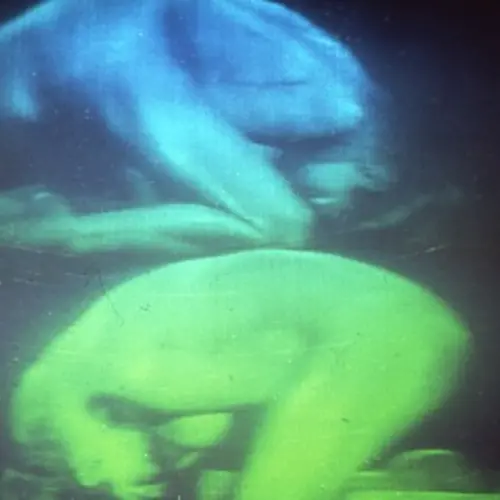Featuring Nicole Abischer, Stephen A. Benton, Margaret Benyon, Rudie Berkhout, Hans Bjelkhagen, Harriet Casdin-Silver, Peter Cresswell, Yuri Denysiuk, Nikfi, Bill Molteni, Sam Moree, Ruben Nunez, Nick Phillips, Al Razutis, William Reber, Dan Schweitzer, Rick Silberman & Anait Arutuboff Stephens
This month the exhibition spaces are given over to shows that in one way or another explore some of the new technology available two photographers and artists and the ways in which photographic images can be used and changed by their presentation from documents to art objects simply by intention – and vice versa.
In the room we are showing a number of holograms, made by artists with occasional collaboration of scientists. Increasingly, artists are being allowed to use the facilities originally designed by scientists for research into laser technology. The introduction of the artists mind into the world of complicated experimental science could produce only confusion, but in the examples we have here, there really are new dye mentions and some astoundingly beautiful creations which have resulted from the combination. The lateral thinking of the artists superimposed on the facilities of the scientists is in an early enough stage for it to be a good example of what has happened throughout the history of photography. Technology and art have always gone hand-in-hand in this medium, the introduction of the small camera allowed a freedom that was seized on by photographers who saw it’s possibilities and the more they utilized its speed and lightness the more the manufacturers work encouraged to develop cameras that could make these qualities more easily available.
Holography is still mysterious to most of us and several colleges are now trying to make it available to their students; it is becoming less expensive and cumbersome affair to set up and a showing of the resulting holograms is getting more and more easy. As you’ll see from the exhibition, the old days of entirely dark rooms and massive lasers for the reading of the pieces are quickly being superseded by white light transmission and reflection holograms which make the pictures easy to see in ordinary home environments.
Apart from the holograms we also have some pieces made with the new Nimslo camera which is designed for everyday amateur use as well as for the professionals this alternative three-dimensional image is not as visually exciting as the holograms what it has the advantage of being for more movable and does allow the user the freedom he is used to in time and place and subject.
I feel that both of these processes have a long way to go and it is quite likely that other as yet unmade technologies will develop for the three-dimensional documenting of objects and places. It does seem however, a good time to show what has been and what can be done now and to let people who may be interested in using the technique just what has been achieved so far and to allow them a chance to decide for themselves if the systems are of interest to them as artists, users or consumers.
Eve Ritscher, the administrator of the Richard Payne Collection and international holography consultant is invaluable advice and hard work has been instrumental in the collation of this exhibition has written a good piece in the accompanying catalogue of the exhibition which I would like to quote below:
Holography is a means of reconstituting or replicating fully three-dimensional images on a flat surface–the next stage on from photography. It has creatively just reached its first decade and like most technologies and all artforms, pornography is a true craft, and as artists have learnt to create rather than copy reality, as technology is catching up with their imagination, we see that holograms offer visual possibilities and sensations which would be impossible in any other medium.
From abstract holograms, by their nature highly graphic and frequently kinetic, with their dramatic use of dimensional form and saturated colour, to symbolic imagery making full use of the medium’s reality to add the weight of form to the intellectual content, from collage, with painting and etching, each artist finding a personal use of particular techniques available in holography to express their own individual style.
Holography’s present practitioners remain highly individualistic pioneers, both in the medium that they have chosen and in the methods they have chosen with which to express their art. This exhibition represents their early search for what is viable holographically as art, as well as some of the further technical possibilities of the scientists who help enable that vision. The virtuosity displayed in these pieces adds a new and very contemporary die mention to the notion of craftsmanship.
View the publication for Light Years Ahead
Information for this exhibition is currently incomplete or yet to be catalogued.
We’re working to document our past programme using material in our Archive, and so information on this exhibition may become available in the future.
Can you help us? If you visited or were involved with this exhibition and have information you can share with us, we’d love to hear from you. You can get in touch using the details below.
Likewise if you spot anything incorrect, have any further information that would improve this listing, or want to share a memory of TPG please contact us at tpg.archive@tpg.org.uk
For further details on our past programme, visit our Archive and Study Room.








